Nikon D300
-
-
Written by Gordon Laing
Nikon D300 Studio resolution / JPEG and RAW results
Nikon D300 results continued…
Outdoor resolution / Studio resolution / Real life Noise / Low light noise
| Support this site by shopping at Amazon | |||||||||||||||||||||||||||||||
 |
To measure and compare the Nikon D300’s resolving power we photographed the Enhanced Digital Camera Resolution Chart with it and a number of rival models, each using their best quality JPEG and default image tone and sharpening settings. We tested the Nikon D300 using the Nikkor DX 17-55mm f2.8 lens at all apertures and selected the sharpest result. The crops are taken from the original images, saved as High Quality JPEGs in Photoshop CS2 and presented here at 100%. Each number represents 100 lines per picture height (lpph), so a figure of 20 means a resolution of 2000 lpph. |
Set to Large Fine JPEG mode, Standard Picture Style, and fitted with a Nikkor DX 17-55mm f2.8 lens at f8, the Nikon D300 resolved 2250 and 2300 lpph of horizontal and vertical resolution respectively. This is a small but measureable improvement over the 2200 lpph scored by the D200 in our tests, although to be fair they were taken with a 50mm f1.8 prime lens. We will test the D300 again with the same lens in the future and report back. The D300’s scores here rank it above the 10 Megapixel Canon EOS 40D, although as we illustrated in our Sony A700 outdoor resolution page, this doesn’t necessarily translate into that much greater detail in real-life subjects. Speaking of the Sony A700, it delivered slightly better results than the D300 with its default settings and fitted with the DT 16-80mm lens. We should also note the D300’s JPEG studio resolution results are only fractionally better than the D80 as seen in our 10 Megapixel group test, so anyone thinking of upgrading for a significant boost in resolving power should think again. The D300 can record greater detail than seen in its default JPEGs below, but you’ll need to shoot in RAW to unlock it. Scroll to the bottom of this page to see RAW resolution results. To see how the D300 performs in terms of noise levels against the Sony A700 and Canon 5D, check out our Nikon D300 noise results. |
Nikon D300 with Nikkor DX 17-55mm f2.8 |
Canon EOS-40D with Canon EF 85mm f1.8 USM | |
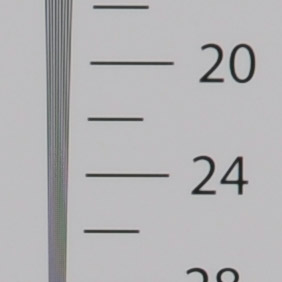 | 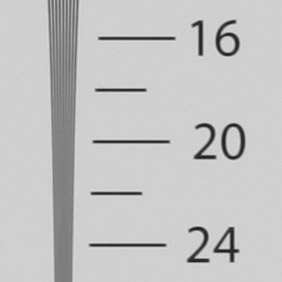 | |
2250 lpph, DX 17-55mm at 35mm, f8, 100 ISO |
1950 lpph, 85mm, f8, 100 ISO | |
Sony Alpha DSLR-A700 with Sony DT 16-80mm |
Canon EOS-5D with Canon EF 85mm f1.8 USM | |
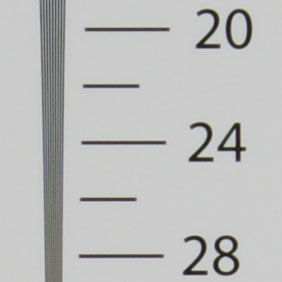 | 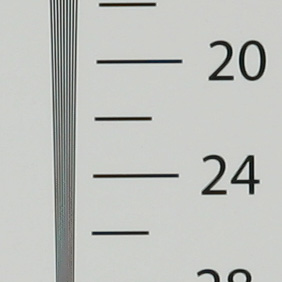 | |
2350 lpph, DT 16-80mm at 35mm, f8, 100 ISO |
2400 lpph, 85mm, f8, 100 ISO |
Nikon D300 with Nikkor DX 17-55mm f2.8 |
Canon EOS-40D with Canon EF 85mm f1.8 USM | |
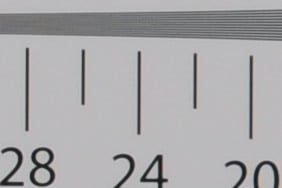 | 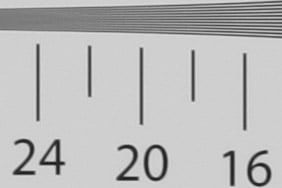 | |
2300 lpph, DX 17-55mm at 35mm, f8, 100 ISO |
2100 lpph, 85mm, f8, 100 ISO | |
Sony Alpha DSLR-A700 with Sony DT 16-80mm |
Canon EOS-5D with Canon EF 85mm f1.8 USM | |
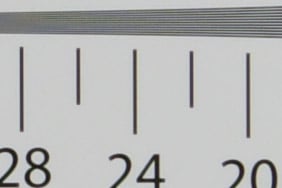 | 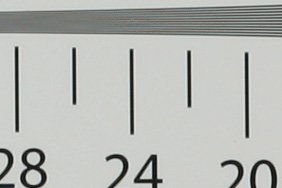 | |
2400 lpph, DT 16-80mm at 35mm, f8, 100 ISO |
2300 lpph, 85mm, f8, 100 ISO |
Nikon D300 Studio resolution: JPEG versus RAW
We photographed the test chart in the D300’s Large Fine JPEG plus 14-bit RAW mode, allowing us to directly compare images created from exactly the same data. Below are crops taken from the original JPEG file alongside the RAW version, processed in Nikon Capture NX 1.3 – 23092 using the default settings, saved as a 16-bit TIFF, then opened in Photoshop. As you can see, the RAW version, even without tweaking, reveals better defined details and a boost in resolving power.
As we also saw on the Canon EOS 40D, the D300’s default JPEG files can certainly handle a little additional sharpening, but the RAW result is still ultimately preferred. So again if you want punchier output from the D300, consider a slight in-camera boost in sharpness and contrast, or better still, shoot in RAW. Now let’s check out the camera’s performance at different sensitivities in our Nikon D300 noise results page.
Nikon D300 JPEG with Nikkor DX 17-55mm f2.8 |
Nikon D300 RAW with Nikkor DX 17-55mm f2.8 | |
 | 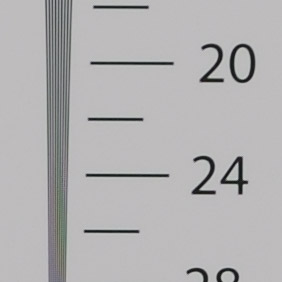 | |
2250 lpph, DX 17-55mm at 35mm, f8, 100 ISO |
2300 lpph, DX 17-55mm at 35mm, f8, 100 ISO |
Nikon D300 JPEG with Nikkor DX 17-55mm f2.8 |
Nikon D300 RAW with Nikkor DX 17-55mm f2.8 | |
 | 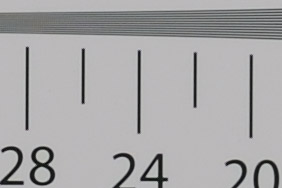 | |
2300 lpph, DX 17-55mm at 35mm, f8, 100 ISO |
2400 lpph, DX 17-55mm at 35mm, f8, 100 ISO |




